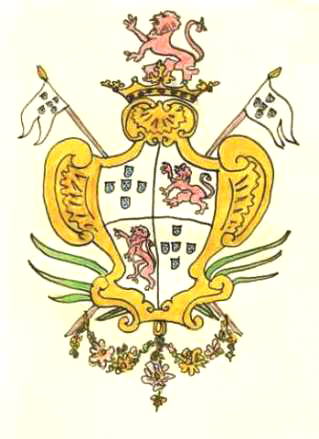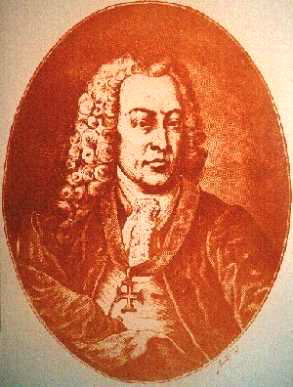


Portugal, Pombal, Pauline...
Introduction by Marco Leeflang
This summer I met Alfredo M Ramalho, executive director of the Lisbon library of the Catholic University.
When we talked about Casanova I mentioned the story of Pauline as Casanova tells it in his Memoirs (vol.9, ch.9). I said that the story is generally regarded as a romantic invention but that I hoped that someday a Portuguese with knowledge of the 18th century genealogy would have a good look at it.
It turned out that Ramalho himself was a seasoned genealogist, and he volunteered to give it a try.
Just imagine my pleasant surprise when I got the following e-mail:
Marco, hello to you! By now you must have thought that I have completely forgotten poor Pauline and our nice conversation on your balcony at Poujol, but I did not: I am stubborn like "la mule du Pape" in Daudet's funny story, and here I am, coming to you after many a week with some fresh news!!!
Sebastiao José Carvalho e Mello, Count of Oeiras and Marquis of Pombal. Oil by Van Loo. With kind permission of the Oeiras municipality.
-In 1763 Pauline was 22 years old, which means she was born in 1741;Even ASSUMING that there is a real case behind this story, I think there are some imprecisions or confusions: for instance, the attempt to the King's life happened in 1758, to come out of the convent in 1759 after her father's death would not be such a big deal, if she only went there because of that she would have stayed only one year, one would not say that she was educated in that convent ! So, being very probable that she had been educated in that convent, which was the very general rule to any noble orphan girl, the fact probably had nothing to do with the Attempt - any relationship with it probably is artificial and fictitious, purely romanesque, and the only relevant detail would be that at that time both her Parents were already dead, and her Grandfather was still alive.-She was the only daughter of the Count of X., whom the prime minister Pombal had put to prison after the attempt to the King's life, his property had not been confiscated but she could only become into it's possession as long as she remained in Portugal;
-She was educated in a convent, of which her Mother's sister was the Abbess;
-When she was 18, in 1759, after her Father's death, she left the convent following the wish of her Grandfather, who made her lodge with his sister in law, the marquise of X...;
-In 1760, her Grandfather announced that the count of F..., whom the Princess of Brazil greatly favoured, had asked her hand for his son, who was returning from some post in Madrid;
-She fell in love with the count of A , with whom she fled to London disguised as a boy when he was posted there in the portuguese embassy, and there she was left when he had to return, and lived for a while, supporting herself with the product of the sale of an extremely valuable ring;
-Through Pombal's unexpected support and influence, she could later return from London to Lisbon and marry him.
 In the year 1763, the heiress to this house and titles was a lady called
Dona
Maria-Francisca de Sousa: she was born in 1745 (not so far from Pauline's
1741), and she got married in 1760 (also not far from Casanova's 1763)
to her cousin Dom Lourenço de Lencastre e Noronha, a grandson of
the 4th count of Arcos. Although in Portugal only the eldest son of a titled
man could use the title, Casanova might very well have been influenced
by the italian use of giving the same title to all the children (as far
as I know, in Italy only the eldest male son will succeed in the title
and estates, but all the children of a count will be called counts, all
the children of a prince will be called princes, etc) - and so, for an
italian the grandson of the count of Arcos could very well be Casanova's
"Count of A..." ? [picture: coat of arms of the SOUSA family]
In the year 1763, the heiress to this house and titles was a lady called
Dona
Maria-Francisca de Sousa: she was born in 1745 (not so far from Pauline's
1741), and she got married in 1760 (also not far from Casanova's 1763)
to her cousin Dom Lourenço de Lencastre e Noronha, a grandson of
the 4th count of Arcos. Although in Portugal only the eldest son of a titled
man could use the title, Casanova might very well have been influenced
by the italian use of giving the same title to all the children (as far
as I know, in Italy only the eldest male son will succeed in the title
and estates, but all the children of a count will be called counts, all
the children of a prince will be called princes, etc) - and so, for an
italian the grandson of the count of Arcos could very well be Casanova's
"Count of A..." ? [picture: coat of arms of the SOUSA family]
1. almost the same year of birth (only 4 years younger)To finish the list of coincidences, another one: this Dona Francisca de Sousa, 5th marquise of Minas, who died in 1787, had two male sons, Dom Francisco de Sousa Lencastre, who was the 6th marquis of Minas, and Dom João de Sousa Lencastre, who succeeded his brother as 7th marquis of Minas, both dying without children; and one daughter, Dona Joana de Noronha, who in 1811, after the deaths of her brothers, became heiress to the house and 8th marquise of Minas.
2. only daughter of a count who died young
3. heiress to a grandfather who was still alive shortly before her marriage
4. almost the same year of marriage (the same 4 years of difference)
5. got married to someone who according to the italian culture would be called a count
6. had a great-aunt who was an abbess in one of the fashionable big Lisbon convents
7. had several aunts who were titled ladies
 In a strange way, she was herself the daughter of one of those Távora
boys, who were involved in the Attempt and got executed, old Pombal
[cf
picture] had no shame to marry his son to the daughter of one of his
own victims ; and she was indeed a distant relative of Dona Joana, on their
Mothers' side : why, among all the relatives who got bits of the Minas
properties, would this Dona Francisca, then already very old (73), get
the biggest and most significant part?
In a strange way, she was herself the daughter of one of those Távora
boys, who were involved in the Attempt and got executed, old Pombal
[cf
picture] had no shame to marry his son to the daughter of one of his
own victims ; and she was indeed a distant relative of Dona Joana, on their
Mothers' side : why, among all the relatives who got bits of the Minas
properties, would this Dona Francisca, then already very old (73), get
the biggest and most significant part?
Regards from
Alf , the crazy genealogy
maniac ...
Any comments? Please write the webmaster.
Copyright by Alfredo Magalhaes Ramalho, Lisbon 2002